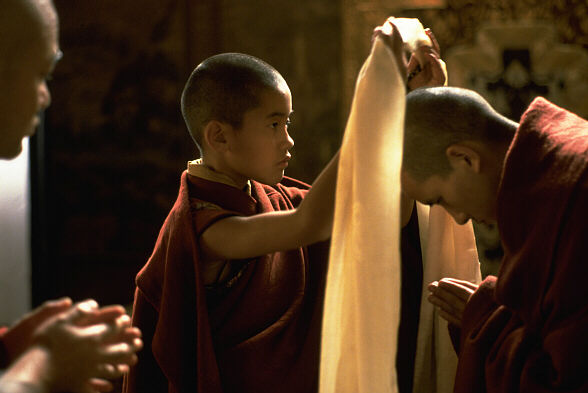
| _____ | _____ |
|

| _____ | _____ |
Starring Tenzin Thuthob Tsarong, Gyurme Tethong, Tulku Jamyang Kunga Tenzin, Tenzin Yeshi
Paichong, Tencho Gyalpo, Tsewang Migyur Khangsar, Lobsang Samten, Gyatso Lukhang, Robert
Lin. Written by Melissa Matheson. Cinematogrpahy by Roger Deakins. Directed by Martin Scorsese.
Tibet is a country tucked into the Himalayan and other mountain systems, to the west of China and north of India. In the 7th century, Buddhism was introduced into the region, and it has been the dominant cultural force in Tibet since. Genghis Kahn conquered Tibet in 1206, but was impressed with the wisdom of the Buddhist monks who governed the country, called Lamas. The Mongols gave the country back to the Tibetans in 1270, and it was ruled locally until the 17th century, where it has been off and on under Chinese rule. It was taken over by Mao in the early 1950's, and it continues to be ruled by the communists. The first Dalai Lama, or head Lama, was installed by the Mongols in 1578, and the current Dalai Lama is the 14th, and he has lived in exile in India since 1959. The country has been run by the Panchen Lama in the Dalai Lama's absence, the second highest Lama, who was co-opted by the Communist regime upon its original takeover. It is the Tibetan's belief that when a Dalai Lama dies, his spirit comes back to earth in a new baby, who will someday grow to lead his people spiritually, and as its governor. Officials scour the land to find the new Dalai Lama, and after passing a few tests, the boy is educated in the ways of Buddhism, and wise governance. Upon his 18th birthday, he is installed as the Dalai Lama. The term Kundun is a Tibetan word indicating the great holy leader that is the Dalai Lama. The film begins with an isolated, rural family with a precocious young boy (Tenzin) who seems to know a lot of things he was never previously taught. He is discovered, given the tests and declared to be Kundun, the incarnation of the Dalai Lama. He is shown the monk way of prayer to Buddha, conducting chants and hymns, reading holy texts and the belief that pride is thing most responsible for causing misfortune. He also learns of the world through radio, and smuggled in movies and news footage, learning about World War II and the atom bomb. All is well until 1949, when the rebel forces led by Mao gain power in China, and declare Tibet to be Chinese property. The Kundun (Tsarong) strives to practice non-violence, and decides to compromise and co-operate with the Chinese, allowing the Dalai Lama to run domestic affairs, while the Chinese took care of Tibet's foreign relations. In meeting with Mao, Mao utters his famous line "religion is the opiate of the masses", (although the film inserts "people" instead of "masses"). Kundun believes prayer and decency will eventually stop the communists, and he's shocked to discover his monks aren't such strong believers - they have a secret cache of guns hidden in a monestary. His most trusted aide tells him "non-violence means co-operation when it is possible, and resistance when it is not." In the late 1950's, the Chinese begin to grow more domineering and violent, bombing and killing innocent citizens. Kundun flees through the mountains to India, and has lived there ever since. The Dalai Lama assisted Matheson (E. T., The Black Stallion) with the story, and it shows. The Tibetans and monks are shown as devout, profoundly decent people, and the Chinese as loutish infidels, although Scorcese does indicate the great hardship and starvation the Chinese people experienced before Mao's reign, and their desire to use Tibet to produce food and goods for the homeland. And the story is very thin and slow moving, with little dramatic excitement or conflict. But the thrust of the movie is not meant to be conflict, but the spiritual nature of the Tibetan culture. The film is amazingly beautiful. Shot after shot of mountains, lavish costumes, and tapestries of coloured sand overwhelm. One striking scene is of a dream where Kundun has a premonition of dead, bloodied monks blanketing the ground. The actors are all unfamiliar Asians, who provide the film with authenticity, and mostly strong acting. The Kundun is played by four actors from 2 to adulthood, with the oldest (Tsarong) standing out. His main aide (Gyalpo) also stands out, displaying strength and loyalty. Different from most films about non-White cultures is that there are no white characters - they are all Asian, and this aids the atmosphere of the film. Despite the slow going, Kundun is well worth the effort.     |